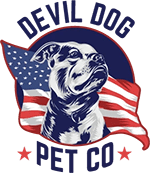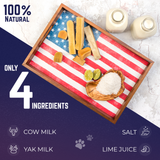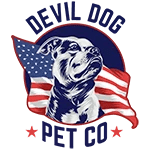Beef Heart for Dogs: The Organ Meat Revolution
Raw feeding and organ meat supplementation are exploding in popularity among dog owners who want to move beyond kibble. At the center of this movement sits beef heart for dogs—a nutrient-dense powerhouse that's technically muscle meat, not organ meat, but packs the concentrated nutrition profile that makes it a game-changer for canine health.
Key Takeaways
- Beef heart is gaining popularity among dog owners who prefer raw feeding and organ meat supplementation.
- Although beef heart is technically muscle meat, it is often grouped with organ meats due to its rich nutritional content.
- Beef heart provides a concentrated nutrition profile that benefits canine health significantly.
- Incorporating beef heart into a dog's diet is considered a revolutionary approach beyond traditional kibble feeding.
Table of Contents
- Beef Heart for Dogs: The Organ Meat Revolution
- Why Beef Heart Stands Apart
- Sourcing and Quality: Your First Line of Defense
- Preparation Methods: Raw, Cooked, or Dehydrated
- Serving Sizes and Dietary Integration
- Monitoring Your Dog's Response
- Where to Buy Quality Beef Heart for Dogs
- Cost Analysis and Budgeting
- Long-Term Feeding Strategy
- Making the Right Choice for Your Dog
Unlike liver or kidney, beef heart delivers high-quality protein without the risk of vitamin A toxicity. It's loaded with taurine, CoQ10, and B vitamins that support everything from cardiovascular function to energy metabolism. But here's the thing: most commercial dog foods barely scratch the surface of what your dog's ancestral diet provided.
The question isn't whether beef heart offers benefits—it's whether you're ready to take ownership of your dog's nutrition and do it safely. As with any significant dietary change, the devil's in the details: sourcing, preparation, portion control, and gradual introduction.
Quick Answer
Yes, beef heart is safe for dogs when properly sourced, prepared, and fed in appropriate portions. It's technically muscle meat (not organ meat) that provides high-quality protein, taurine, B vitamins, and iron without the vitamin A toxicity risk of liver. Start with 5-10% of your dog's total diet, choose grass-fed sources when possible, and introduce gradually to avoid digestive upset. Always consult your veterinarian before making significant dietary changes.
Why Beef Heart Stands Apart

Beef heart isn't just another protein source—it's a nutritional Swiss Army knife that addresses multiple health needs simultaneously. While your dog's kibble might list "chicken meal" or "beef by-products," beef heart delivers targeted nutrition that mirrors what wild canines consumed for thousands of years.
Pros
- Extremely high in taurine for heart and brain health
- Rich in CoQ10 and B vitamins for energy metabolism
- Lower vitamin A content than liver (reduced toxicity risk)
- Excellent source of iron, zinc, and phosphorus
- More affordable than premium muscle meats
- Highly palatable for most dogs
Cons
- Requires careful sourcing and handling for safety
- Can cause digestive upset if introduced too quickly
- May not be suitable for dogs with specific protein allergies
- Needs to be balanced with other proteins and nutrients
- Raw feeding increases pathogen exposure risk
The taurine content alone makes beef heart worth considering. This amino acid supports cardiac muscle function, retinal health, and cognitive performance—yet it's often deficient in commercial dog foods, especially grain-free formulas. A 3.5-ounce serving of beef heart contains approximately 65mg of taurine, compared to just 13mg in the same amount of ground beef.
Sourcing and Quality: Your First Line of Defense
Not all beef heart is created equal. The difference between grass-fed, pasture-raised heart and conventional feedlot sources can be dramatic—both in nutritional content and safety profile.
Grass-fed beef heart typically contains higher levels of omega-3 fatty acids, conjugated linoleic acid (CLA), and antioxidants like vitamin E. These cattle aren't pumped full of antibiotics and growth hormones, reducing your dog's exposure to pharmaceutical residues.
When shopping for beef heart dog food or raw ingredients, prioritize these sourcing standards:
- Human-grade certification ensures the meat meets standards for human consumption
- USDA organic or grass-fed labels indicate higher welfare and nutritional standards
- Local sourcing reduces transportation time and allows for better traceability
- Frozen vs. fresh options both work well; frozen actually reduces bacterial load
Pro tip: Many owners ask where to buy beef heart for dogs. Your best bets are local butchers, farmers' markets, specialty pet stores, and online raw food suppliers. Avoid grocery store heart that's been sitting in display cases—freshness matters for both safety and palatability.
The form factor matters too. You'll find beef heart available as whole organs (requiring home preparation), ground blends, freeze-dried treats, or as part of complete raw meal formulations. Each has its place depending on your comfort level with raw feeding and your dog's specific needs.
Preparation Methods: Raw, Cooked, or Dehydrated

The beauty of beef heart lies in its versatility—you can serve it raw, lightly cooked, or dehydrated, each method preserving different nutritional benefits. Your choice depends on your comfort level with raw feeding, your dog's digestive sensitivity, and your preparation preferences.
Raw feeding maintains maximum enzyme activity and nutrient density. Cut the heart into appropriately sized chunks—thumb-sized for large breeds, smaller for medium dogs, and dice-sized for toy breeds. Remove any visible fat deposits and connective tissue that might be tough to digest.
Light cooking offers a middle ground for owners concerned about pathogens. Steam or lightly sauté the heart for 3-5 minutes—just enough to kill surface bacteria while preserving most nutrients. Avoid oils, seasonings, or high-heat cooking that destroys delicate vitamins.
Dehydrating creates shelf-stable treats perfect for training rewards. Slice the heart into thin strips and dehydrate at 145°F for 6-8 hours until completely dry. These keep for months and provide concentrated nutrition in convenient portions.
Storage protocol: Raw heart stays fresh in the refrigerator for 1-2 days maximum. For longer storage, portion into meal-sized amounts and freeze for up to 6 months. Always thaw in the refrigerator, never at room temperature where bacteria multiply rapidly.
Serving Sizes and Dietary Integration
The biggest mistake owners make with beef heart dog food is treating it like a complete meal replacement. Heart should complement, not dominate, your dog's nutritional profile. Start conservative and build gradually based on your dog's response.
| Dog Weight | Starting Amount (Daily) | Maximum Amount (Daily) | Introduction Period |
|---|---|---|---|
| 10-25 lbs | 0.5-1 oz | 1-2 oz | 7-10 days |
| 25-50 lbs | 1-2 oz | 2-4 oz | 7-10 days |
| 50-75 lbs | 2-3 oz | 4-6 oz | 10-14 days |
| 75+ lbs | 3-4 oz | 6-8 oz | 10-14 days |
Follow the 10% rule: organ meats and heart should never exceed 10% of your dog's total daily caloric intake. For most dogs, this translates to 5-10% of their diet being beef heart, with the remainder coming from other muscle meats, bones, and vegetables if you're following a raw feeding model.
When integrating beef heart into commercial dog food, reduce the kibble portion proportionally to maintain proper caloric balance. A 50-pound dog eating 3 cups of kibble daily should drop to 2.5 cups when adding 2 ounces of beef heart.
Monitoring Your Dog's Response

Every dog responds differently to dietary changes, and beef heart is no exception. Watch for both positive improvements and potential concerns during the introduction period.
Positive indicators include increased energy levels, improved coat shine, better muscle tone, and enhanced appetite for regular meals. Many owners report their dogs show more enthusiasm during training sessions and recover faster from exercise.
Warning signs require immediate attention: loose stools lasting more than 2 days, vomiting, excessive gas, skin irritation, or behavioral changes like lethargy or hyperactivity. These symptoms suggest either too rapid an introduction or an underlying sensitivity.
Digestive adaptation timeline: Most dogs adjust to beef heart within 5-7 days. If digestive upset persists beyond this window, reduce the portion size by half and extend the introduction period. Some dogs with sensitive stomachs may need 2-3 weeks to fully adapt.
Keep a feeding log during the first month, noting portion sizes, preparation methods, and your dog's response. This documentation helps identify patterns and provides valuable information for your veterinarian if issues arise.
For dogs with existing health conditions—particularly heart disease, kidney problems, or food allergies—consult your veterinarian before introducing beef heart. While generally safe, the high protein and mineral content may require dosage adjustments for certain medications or therapeutic diets.
Where to Buy Quality Beef Heart for Dogs
Finding reliable sources for beef heart requires knowing what to look for and where to shop. Not all suppliers maintain the same quality standards, and the difference between premium and subpar heart can impact both safety and nutritional value.
Local butcher shops often provide the freshest option and can source grass-fed heart on request. Build a relationship with your butcher—they'll set aside quality pieces and may offer bulk pricing. Many butchers also carry other organ meats, letting you diversify your dog's diet efficiently.
Specialty pet stores increasingly stock frozen raw beef heart specifically for dogs. These products undergo additional safety testing and come pre-portioned for convenience. Expect to pay 20-30% more than butcher prices, but the peace of mind and consistent quality often justify the cost.
Online suppliers offer the widest selection, particularly for grass-fed and organic options. Companies like Raw Paws Pet Food, Darwin's Natural Pet Products, and Primal Pet Foods ship frozen heart nationwide. Order in bulk to offset shipping costs and ensure consistent supply.
Quality markers to demand: USDA-inspected facilities, grass-fed certification, human-grade processing, and clear sourcing information. Avoid suppliers who can't provide origin details or processing methods.
Farmers markets and local farms provide direct-from-source options with complete transparency. Many cattle ranchers sell organ meats at reduced prices since human consumption demand remains low. This route often delivers the best value for premium quality.
When buying frozen heart, inspect packaging for ice crystals or freezer burn, which indicate temperature fluctuations that compromise quality. Fresh heart should have a deep red color, firm texture, and minimal odor—any ammonia smell signals spoilage.
Cost Analysis and Budgeting
Understanding the true cost of feeding beef heart helps you budget effectively and compare value across different protein sources. While organ meats appear expensive per pound, their nutrient density often makes them more economical than premium kibble.
| Source | Price Range (per lb) | Quality Level | Best For |
|---|---|---|---|
| Local Butcher | $3-6 | Variable | Fresh, custom cuts |
| Pet Store (Frozen) | $8-12 | High | Convenience, safety |
| Online Specialty | $6-10 | Premium | Grass-fed, bulk orders |
| Farm Direct | $2-4 | Excellent | Best value, transparency |
A 50-pound dog eating 3 ounces of beef heart twice weekly consumes roughly 1.5 pounds monthly. At $6 per pound, this adds $9 monthly to feeding costs while potentially reducing kibble expenses by $15-20 due to improved satiety and nutrition.
Bulk purchasing reduces per-pound costs significantly. Buying 10-20 pounds at once and freezing in meal-sized portions often drops prices by 15-25%. Split large orders with other dog owners to maximize savings while maintaining freshness.
Long-Term Feeding Strategy
Successful beef heart integration requires viewing it as part of a comprehensive nutrition plan, not a quick fix. The most effective approach involves gradual introduction, consistent monitoring, and strategic rotation with other protein sources.
Establish a feeding schedule that works with your routine and your dog's digestive patterns. Many owners find success with beef heart 2-3 times weekly, alternating with other organ meats like liver or kidney. This rotation prevents nutrient imbalances while maintaining dietary interest.
Long-term Benefits
- Improved cardiovascular health from consistent taurine intake
- Enhanced muscle development and recovery
- Better coat quality and skin health
- Increased energy and vitality
Considerations
- Requires consistent sourcing and preparation time
- Higher upfront costs compared to kibble
- Need for proper storage and handling protocols
- Potential for nutrient imbalances if not properly balanced
Track your dog's response over months, not days. True nutritional benefits from beef heart often take 6-8 weeks to become apparent. Document changes in energy levels, coat quality, muscle tone, and overall health markers during regular veterinary checkups.
Consider seasonal adjustments—active dogs may benefit from increased portions during training seasons, while older dogs might need reduced amounts as metabolism slows. Flexibility in your approach ensures the feeding strategy remains appropriate as your dog ages and their needs change.
Making the Right Choice for Your Dog
Beef heart for dogs represents a powerful nutritional tool when used correctly. Its exceptional protein quality, taurine content, and mineral profile can significantly enhance your dog's health, but success depends on proper sourcing, preparation, and integration into a balanced diet.
Start conservatively with high-quality, properly sourced heart. Monitor your dog's response closely during the introduction period, and don't hesitate to adjust portions or preparation methods based on their individual needs. Remember that every dog is unique—what works perfectly for one may require modifications for another.
The investment in quality beef heart pays dividends in your dog's long-term health, energy, and vitality. When you see your dog's coat gleaming, their energy sustained throughout the day, and their overall enthusiasm for life enhanced, you'll understand why this nutrient-dense organ meat has earned its place in optimal canine nutrition.
Take ownership of your dog's nutritional future. Research your sources, start gradually, and commit to the process. Your dog's health is worth the extra effort, and the results will speak for themselves in their improved quality of life and longevity. For more tips and canine nutrition insights, check out the devil dog blog.
For a deeper dive into the science behind raw feeding and organ meats, review this external resource on canine nutrition.
Download the FREE 10-Step Dog Prep Guide
Frequently Asked Questions
Is beef heart good for dogs?
Yes, beef heart is an excellent source of lean protein, essential amino acids, and important nutrients like taurine, which supports heart health. It’s nutrient-dense and can be a beneficial addition to your dog’s diet when offered in moderation and properly prepared.
How do I prepare beef heart for my dog?
To prepare beef heart safely, trim excess fat and connective tissue, then either lightly cook it by boiling, baking, or grilling without seasoning or feed it raw if you follow strict hygiene and source high-quality meat. Always cut it into manageable pieces to prevent choking and introduce it gradually to monitor digestion.
What three meats should dogs avoid?
Dogs should avoid processed meats high in salt and preservatives, such as deli meats or sausages, pork products that may carry parasites if undercooked, and raw fish that can contain harmful bacteria or parasites. Additionally, avoid any meat seasoned with garlic, onions, or other toxic ingredients.
Which organ meat is best for dogs?
Liver is generally considered the best organ meat for dogs due to its rich supply of vitamins A, B, iron, and essential minerals. However, it should be fed in controlled amounts because overfeeding liver can cause vitamin A toxicity. Variety with other organs like kidney and heart supports balanced nutrition.
Is it better to feed dogs raw or cooked hearts?
Both raw and cooked hearts can be safe if handled properly. Raw feeding preserves enzymes and nutrients but requires rigorous sourcing and sanitation to prevent bacterial risks. Cooking reduces pathogens and makes the meat easier to digest, but overcooking can diminish some nutrients. Choose based on your dog's tolerance and your comfort with food safety.
Can dogs eat hearts every day?
Feeding hearts daily is possible but not recommended without balancing the rest of the diet. Organ meats, including heart, are nutrient-dense and should make up about 5-10% of total intake to avoid nutrient imbalances. Rotate with other protein sources and organs to ensure comprehensive nutrition and avoid overloading any single nutrient.
Is too much beef heart bad?
Yes, too much beef heart can cause nutrient imbalances, including excessive intake of certain minerals like iron, which may lead to digestive upset or toxicity over time. Overfeeding rich organ meats can also overwhelm your dog’s metabolism, so moderation and a balanced diet are critical.
What is the best meat for dogs?
The best meat for dogs is high-quality, minimally processed, and appropriate for their life stage and health needs. Lean meats like beef, chicken, and turkey provide excellent protein, while organ meats supplement essential vitamins and minerals. Always ensure the meat is fresh, safely prepared, and part of a balanced diet tailored to your dog’s individual requirements.






